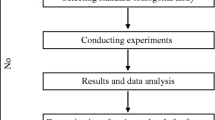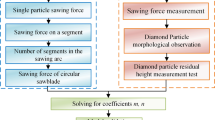Abstract
In this study, a multi-tooth sawing force prediction model is proposed for the stainless steel sawing process, combined with the classical cutting theory of band saw and the introduction of tooth equivalent cutting width. Through the numerical simulation of sawing process and sensitivity analysis method, the influence law of feed speed and cutting speed on cutting force was analyzed. A sawing process parameter optimization design model with sawing force and sawing efficiency as the optimization objectives was established and solved by multi-objective optimization algorithm to determine the optimal combination of coordinated sawing force and sawing efficiency process parameters. The stainless steel sawing test results show that the multi-tooth sawing force prediction model and the experimental results match; the maximum error does not exceed 6%, making it better to achieve the prediction of sawing force in high-frequency strong impact conditions. With the optimized design of process parameters, the sawing force decreased by a maximum 20.43%, and the sawing efficiency increased by a maximum 54.72%. This study provides a reference for metal sawing force prediction and process parameter optimization, and also offers theoretical guidance for developing high-end sawing equipment.























Similar content being viewed by others
Data availability
The authors confirm that the data supporting this study are available within the article.
References
Wang Y, Ni P, Wen D, Tan D, Pan X, Lu H, Wang D (2020) SA-OMA based dynamic characteristics optimization for gear box of sawing machine. Chin High Technol Lett 30(03):314–324
Aryafar A, Mikaeil R, Haghshenas S, Haghshenas S (2018) Application of metaheuristic algorithms to optimal clustering of sawing machine vibration. Measurement 124:20–31. https://doi.org/10.1016/j.measurement.2018.03.056
Wang Y, Zhang Y, Tan D, Zhang Y (2021) Key technologies and development trends in advanced intelligent sawing equipments. Chin J Mech Eng 34(1):175–194. https://doi.org/10.1186/s10033-021-00547-6
Tan D, Zhang L, Ai Q (2019) An embedded self-adapting network service framework for networked manufacturing system. J Intell Manuf 30(2):539–556. https://doi.org/10.1007/s10845-016-1265-3
Li L, Tan Y, Xu W, Ni Y, Yang J, Tan D (2023) Fluid-induced transport dynamics and vibration patterns of multiphase vortex in the critical transition states. Int J Mech Sci 252. https://doi.org/10.1016/j.ijmecsci.2023.108376. Accessed 5 Jun 2023
Deng Z, Wan L, Zhang R (2008) Research progresses of high efficiency and precision grinding for hard to machine materials. Chin Mech Eng 19(24):3018–3023
Bai W (2018) Machining mechanism of vibration assisted cutting and machinability investigations of typical difficult-to-machine materials. Dissertation,. Huazhong University of Science and Technology
Yuan S, He L, Zhan G, Jiang H, Zou Z (2018) Research on surface roughness of 304 stainless steel cut by cemented carbide micro pit tool. J Mech Eng 54(15):232–240. https://doi.org/10.3901/JME.2018.15.232
Ling L, Li X, Wang X, Hu Y (2012) Constitutive model of stainless steel 0Cr18Ni9 and its influence on cutting force prediction. Chin Mech Eng 23(18):2243–2248. https://doi.org/10.3969/j.issn.1004-132X.2012.18.021
Zhou FJ (2014) Research on machined surface characteristics of 304 stainless steel. Dissertation,. Huazhong University of Science and Technology
Li L, Gu Z, Xu W, Tan Y, Fan X, Tan D (2023) Mixing mass transfer mechanism and dynamic control of gas-liquid-solid multiphase flow based on VOF-DEM coupling. Energy 272. https://doi.org/10.1016/j.energy.2023.127015. Accessed 5 Jun 2023
Hu X, Xu F, Tan D (2020) A synchronous sampling-based direct current estimation method for self-sensing active magnetic bearings. J Zhejiang Univ Sci 21(5):401–405. https://doi.org/10.1631/jzus.A2000067
Wang T, Wang C, Yin Y, Zhang Y, Li L, Tan D (2023) Analytical approach for nonlinear vibration response of the thin cylindrical shell with a straight crack. Nonlinear Dynam 111(12):10957–10980. https://doi.org/10.1007/s11071-023-08460-4
Ge J, Ji S, Tan D (2018) A gas-liquid-solid three-phase abrasive flow processing method based on bubble collapsing. Int J Adv Manuf Technol 95(1-4):1069–1085. https://doi.org/10.1007/s00170-017-1250-9
Yin Z, Lu J, Li L, Wang T, Wang R, Fan X, Lin H, Huang Y, Tan D (2020) Optimized scheme for accelerating the slagging reaction and slag-metal-gas emulsification in a basic oxygen furnace. Appl Sci 10(15):5101. https://doi.org/10.3390/app10155101
Ko T, Kim H (1999) Mechanistic cutting force model in band sawing. Int J Mach Tools Manuf 39(8):1185–1197. https://doi.org/10.1016/S0890-6955(98)00087-X
Andersson C, Andersson M, Stahl J (2001) Bandsawing. Part I: cutting force model including effects of positional errors, tool dynamics and wear. Int J Mach Tools Manuf 41(2):227–236. https://doi.org/10.1016/S0890-6955(00)00064-X
Andersson C, Stahl J, Hellbergh H (2001) Bandsawing. Part II: detecting positional errors, tool dynamics and wear by cutting force measurement. Int J Mach Tools Manuf 41(2):237–253. https://doi.org/10.1016/S0890-6955(00)00065-1
Andersson C (2001) Bandsawing. Part III: stress analysis of saw tooth microgeometry. Int J Mach Tools Manuf 41(2):255–263. https://doi.org/10.1016/S0890-6955(00)00066-3
Li BL (2012) Research on analytical prediction of cutting forces in stainless steel machining. Dissertation,. Huazhong University of Science and Technology
Tang J, Lin X, Tang J, Lou J (2012) Force theory simulation research of metal cutting process based on DEFORM-3D software. Int J Mach Tools Manuf 62(8):99–103
Ren Y, Luo Y, Zhou Z, Ou Y (2017) Numerical simulation and process experiment research on sawing force of bandsaw. Tool. Engineering 51(06):15–19. https://doi.org/10.16567/j.cnki.1000-7008.2017.06.003
Lv J, Zhao J, Liu Q (2013) Optimization of cutting parameters based on multi-objective genetic algorithm NSGA- II. Appl Mech Mater 281:517–522. https://doi.org/10.4028/www.scientific.net/AMM.281.517. Accessed 5 Feb 2023
Subramanian M, Sakthivel M, Sooryaprakash K, Sudhakaran R (2013) Optimization of cutting parameters for cutting force in shoulder milling of Al7075-T6 using response surface methodology and genetic algorithm. Procedia Eng 64:690–700. https://doi.org/10.1016/j.proeng.2013.09.144
Gaikhe V, Sahu J, Pawade R (2018) Optimization of cutting parameters for cutting force minimization in helical ball end milling of Inconel 718 by using genetic algorithm. Procedia CIRP 77:477–480. https://doi.org/10.1016/j.procir.2018.08.261
Gurgen A, Cakmak A, Yildiz S, Malkocoglu A (2022) Optimization of CNC operating parameters to minimize surface roughness of Pinus sylvestris using integrated artificial neural network and genetic algorithm. Maderas: Cienc Tecnol 24:1–12. https://doi.org/10.4067/s0718-221x2022000100401
Pedrammehr S, Hejazian M, Qazani M, Parvaz H, Pakzad S, Ettefagh M, Suhail A (2022) Machine learning-based modelling and meta-heuristic-based optimization of specific tool wear and surface roughness in the milling process. AXIOMS 11(9):1–13. https://doi.org/10.3390/axioms11090430
Chen S, Tan D (2018) A SA-ANN-based modeling method for human cognition mechanism and the PSACO cognition algorithm. Complexity 2018:21. https://doi.org/10.1155/2018/6264124
Wang J, Gao S, Tang Z, Tan D, Cao B, Fan J (2021) A context-aware recommendation system for improving manufacturing process modeling. J Intell Manuf 34(3):1347–1368. https://doi.org/10.1007/s10845-021-01854-4
Lyu H, Zhang L, Tan D (2022) The AAPF fault-tolerant method for small and complex product assembly. Proc Inst Mech Eng B: J Eng Manuf 236(8):1007–1021. https://doi.org/10.1177/09544054211059277
Tan D, Chen S, Bao G, Zhang L (2018) An embedded lightweight GUI component library and ergonomics optimization method for industry process monitoring. Front Inf Technol Electron Eng 19(5):604–625. https://doi.org/10.1631/FITEE.1601660
Zhao X (2015) Study on the variation of micro milling forces and specific cutting forces with tool wear. Int J Mach Tools Manuf 7:19–22. https://doi.org/10.13462/j.cnki.mmtamt.2015.07.006
Li X, Tang Z, Chen T (1997) Calculation of cutting force of bimetal band saw blade. Manuf Technol Mach Tool 03:29–31
Li B, Hu Y, Wang X, Li C (2011) Cutting force prediction based on oblique cutting theory in end milling. Chin Mech Eng 22(19):2283–2288
Zhu L (2018) Modeling simulation and testing on milling force of jointed die in consideration of tool wear. Dissertation, Harbin University of Science and Technology
Le-Ngoc L, McCallion H (1999) Self-induced vibration of bandsaw blades during cutting. Proc Inst Mech Eng C J Mech Eng Sci 213(4):371–380. https://doi.org/10.1243/0954406991522329
Okai R, Tanaka C, Iwasaki Y, Ohtani T (2005) Application of a novel technique for band sawing using a tip-inserted saw regarding surface profiles. Holz Als Roh-Und Werkstoff 63(4):256–265. https://doi.org/10.1007/s00107-005-0023-6
Lang J (2018) Analysis and Experimental research on transverse vibration characteristics of textured band saw blade. Dissertation, Hangzhou Dianzi University, Hangzhou
Zheng S, Yu Y, Qiu M, Wang L, Tan D (2021) A modal analysis of vibration response of a cracked fluid-filled cylindrical shell. Appl Math Model 91:934–958. https://doi.org/10.1016/j.apm.2020.09.040
Li L, Lu B, Xu W, Gu Z, Yang Y, Tan D (2023) Mechanism of multiphase coupling transport evolution of free sink vortex. Acta Phys Sin 72(3). https://doi.org/10.7498/aps.72.20221991
Li L, Qi H, Yin Z, Li D, Zhu Z, Tangwarodomnukun V, Tan D (2020) Investigation on the multiphase sink vortex Ekman pumping effects by CFD-DEM coupling method. Powder Technol 360:462–480. https://doi.org/10.1016/j.powtec.2019.06.036
Huang Y, Di O, Li Y (2016) Finite element simulation of aluminum alloy 2A12 turning based on Deform-3D. Mach Manufac 54(6):41–43. https://doi.org/10.3969/j.issn.1000-4998.2016.06.014
Zhang Z, Zhang J, Wang L (2011) FEA of cutting force of stainless steel based on DEFORM-3D. Light Indust Mach 29(4):40–42. https://doi.org/10.3969/j.issn.1005-2895.2011.04.010
Li L, Tan D, Yin Z, Wang T, Fan X, Wang R (2021) Investigation on the multiphase vortex and its fluid-solid vibration characters for sustainability production. Renew Energy 175:887–909. https://doi.org/10.1016/j.renene.2021.05.027
Ge M, Ji M, Tan D, Cao H (2021) Erosion analysis and experimental research of gas-liquid-solid soft abrasive flow polishing based on cavitation effects. Int J Adv Manuf Technol 114(11-12):3419–3436. https://doi.org/10.1007/s00170-021-06752-w
Tan D, Li L, Yin Z, Li D, Zhu Y, Zheng S (2020) Ekman boundary layer mass transfer mechanism of free sink vortex. Int J Heat Mass Transf 150:119250. https://doi.org/10.1016/j.ijheatmasstransfer.2019.119250
Lu J, Wang T, Li L, Yin Z, Wang R, Fan X, Tan D (2020) Dynamic characteristics and wall effects of bubble bursting in gas-liquid-solid three-phase particle flow. Processes 8(7):760. https://doi.org/10.1016/10.3390/pr8070760
Wang Y, Ni P, Wen D, Lin Q, Wang D, Ma C, Rao Y, Wang H, Tan D (2019) Dynamic performance optimization of circular sawing machine gearbox. Appl Sci 9(20):4458. https://doi.org/10.3390/app9204458
Pan Y, Ji S, Tan D (2020) Cavitation based soft abrasive flow processing method. Int J Adv Manuf Technol 109(9-12):2587–2602. https://doi.org/10.1007/s00170-020-05836-3
Li L, Lu J, Fang H, Yin Z, Wang T, Wang R, Fan X, Zhao L, Tan D, Wan Y (2020) Lattice Boltzmann method for fluid-thermal systems: status, hotspots, trends and outlook. IEEE Access 8:27649–27675. https://doi.org/10.1109/ACCESS.2020.2971546
Tan D, Li L, Zhu Y, Zheng S, Yin Z, Li D (2019) Critical penetration condition and Ekman suction-extraction mechanism of sink vortex. J Zhejiang Univ Sci 20(1):61–72. https://doi.org/10.1631/jzus.A1800260
Chen Y, Fan L, Zhang G, Yang D (2020) The NSGA-II algorithm of hydraulic hybrid vehicle powertrain parameter optimization. Machinery Design and Manufacture 11):179-182+187:10.19356/j.cnki.1001-3997.2020.11.045
Deng W, Zhang X, Zhou Y, Liu Y, Zhou X, Chen H, Zhao H (2022) An enhanced fast non-dominated solution sorting genetic algorithm for multi-objective problems. Inf Sci 585:441–453. https://doi.org/10.1016/j.ins.2021.11.052
Zhang L, Lv H, Tan D, Xu F, Chen J, Bao G, Cai S (2018) Adaptive quantum genetic algorithm for task sequence planning of complex assembly systems. Electron Lett 54(14):870–871. https://doi.org/10.1049/el.2018.0609
Code availability
Custom codes were implemented in the software as explained in details in the manuscript.
Funding
The authors received financial support from the projects of the Natural Science Foundation of China (grant number 51705463).
Author information
Authors and Affiliations
Contributions
All authors contributed to the research, writing, and reviewing of the paper.
Corresponding author
Ethics declarations
Ethics approval
Not applicable.
Consent to participate
Not applicable.
Consent for publication
All authors have agreed to authorship, read and approved the manuscript, and given consent for submission and subsequent publication of the manuscript. The authors guarantee that the contribution to the work has not been previously published elsewhere.
Competing interests
The authors declare no competing interests.
Additional information
Publisher’s note
Springer Nature remains neutral with regard to jurisdictional claims in published maps and institutional affiliations.
Rights and permissions
Springer Nature or its licensor (e.g. a society or other partner) holds exclusive rights to this article under a publishing agreement with the author(s) or other rightsholder(s); author self-archiving of the accepted manuscript version of this article is solely governed by the terms of such publishing agreement and applicable law.
About this article
Cite this article
Ni, P., Wang (CA), Y., Tan, D. et al. Research on optimization method of stainless steel sawing process parameters based on multi-tooth sawing force prediction model. Int J Adv Manuf Technol 128, 4513–4533 (2023). https://doi.org/10.1007/s00170-023-12051-3
Received:
Accepted:
Published:
Issue Date:
DOI: https://doi.org/10.1007/s00170-023-12051-3




